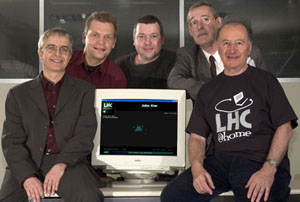|
|
What is LHC@home? 什么是LHC@HOME?
History of LHC@home LHC@HOME的历史
In 2003, Eric McIntosh and Andreas Wagner of CERN’s IT Department started testing an in-house screensaver called the Compact Physics Screen Saver (CPSS), which runs SixTrack on desktop computers at CERN. CPSS has proved to be a vital tool for debugging this kind of distributed computing application. Today, CPSS runs on over 200 PCs at CERN. An important discovery made with CPSS, and confirmed with LHC@home, is that different PC processors can return different results. Eric McIntosh tracked this problem down to the ways that certain mathematical functions such as exponential and tangent handle rounding errors on different processors.
2003年,CERN(欧洲粒子物理研究所) IT部门的Eric McIntosh 和 Andreas Wagner 展开对一款名为CPSS (Compact Physics Screen Saver) 屏保的测试。在屏幕保护的同时运行SixTrack。CPSS被视为是一个分布式计算工作重要工具。今天,在CERN使用CPSS的计算机一远不只200台。不同的PC可以分析不同的WU 。 Eric McIntosh 利用严密的数学函数,解决了在不同计算机上所出现的问题。
In January of 2004, Ben Segal and François Grey of the IT Department were asked to plan an outreach event for CERN’s 50th anniversary that would allow people around the world to get an impression of the computational challenges facing the LHC. Ben and François got in touch with Dave Anderson, the Director of SETI@home, who was just beginning to test the new BOINC platform his team had developed. At the same time, a couple of Danish students got in touch with François, eager to find an exciting project for their Masters thesis. This was the beginning of LHC@home. Christian Søttrup and Jakob Pedersen worked furiously all spring and summer to get SixTrack and BOINC to function together. You can read their thesis , which describes the opportunities for combining public resource computing, such as LHC@home, with Grid computing like the LHC Computing Grid.
2004年1月,Ben Segal 和François Grey 被任命在CERN的五十周年庆典之际,把分布式计算以及LHC推向全世界。他们接触到SETI@HOME的主管Dave Anderson。那时,Anderson先生正在测试新的BOINC平台。与此同时,一些丹麦学生找到了François,他们十分热衷于参加此计划,因为这对于他们的硕士论文十分有用。着就是LHC@HOME的开始。Christian Søttrup 和 Jakob Pedersen 用整个春天和夏天的时间,试图把SixTrack和BOINC平台衔接起来。他们简直是典型的工作狂。您能从他们的文章中,找到关于分布式计算像LHC@HOME的描述。
Some of the people behind screensaver computing at CERN. From left to
right, Frank Schmidt (AB), Jukka Klem (Helsinki Institute of Physics),
Andreas Wagner (IT), Eric McIntosh (IT) and Ben Segal (IT).
这些为CERN工作人员,左起
Frank Schmidt(AB成员),Jukka Klem(赫尔辛基物理协会成员), Andreas Wagner,Eric McIntosh,and Ben Segal (CERN IT部门)
Over the summer 2004, a student from Berkeley, Karl Chen, who had been working with Dave Anderson, came over to help Christian and Jacob with the BOINC interface. Jasenko Zivanov, a summer student from Basel University, developed the screensaver graphics. Kalle Happonen and Markku Degerholm, two Finnish students from the Helsinki Institute of Physics technology programme, took turns to set-up and help manage the BOINC server, as the LHC@home team went from alpha-phase, with 25 in-house computers, to beta-phase, with some experienced BOINC users, and finally live in September, just in time for CERN’s 50th anniversary on September 29th, and the CERN openday that followed on October 16th, where over 30,000 people visited CERN. During those months, the user base grew to 6000, which was judged to be the maximum one could cope with given server limitations and the challenge of actually analyzing all the data coming back.
2004年夏天以后,一位来自Berkeley(伯克利)的学生 Karl Chen 前来帮助Christian和Jacob和BOINC方面的人员一起工作。他曾和Dave Anderson 共事。一位来自Basel大学的学生Jasenko Zivanov 对CPSS的屏保画面做了修改。两位从赫尔辛基物理协会的计划中毕业的学生轮流负责对BOINC服务器的设置和管理工作。随着LHC@HOME顺利通过第一和第二阶段的调试,程序终于在9月份和BOINC平台衔接成功。而这胜利的一天,正是CERN建立50周年的纪念日——九月29号。单在10月16号CERN开放日这一天,超过30000人次来到了CERN。几个月以后,SixTrack的用户超过了6000。这被认为是服务器所能承受的最大吞吐量。
In February 2005, after a break of a few months, LHC@home was restarted as a mainstream service of the CERN IT Department, and as part of the Year of Physics events. Ignacio Reguero is managing the project, and together with Phil Defert and Ben Segal they are beginning to look into possible new applications with other partners in the High Energy Physics community. Eric McIntosh and Frank Schmidt continue to work hard to supply data to users of LHC@home, and analyze the results. Jukka Klem of the Helsinki Institute of Physics technology programme at CERN is supporting the day-to-day running of the server, managing the message boards.
LHC@HOME在数月的暂停之后,于2005年2月重启。对LHC@HOME用户的服务成为了CERN IT部门的主要工作。LHC@HOME重启也是当年物理界的大事之一。Ignacio Reguero正在管理此项目。他与Phil Defert 和 Ben Segal一起在High Energy 物理协会中寻找其他合作伙伴。目的是为了开发新的软件。Eric McIntosh 和 Frank Schmidt继续为给用户提供数据和分析数据而努力工作。赫尔辛基物理协会在CERN科技计划的参与者Jukka Klem 正在管理24小时工作的服务器,以及Message Board。 |
-

评分
-
查看全部评分
|